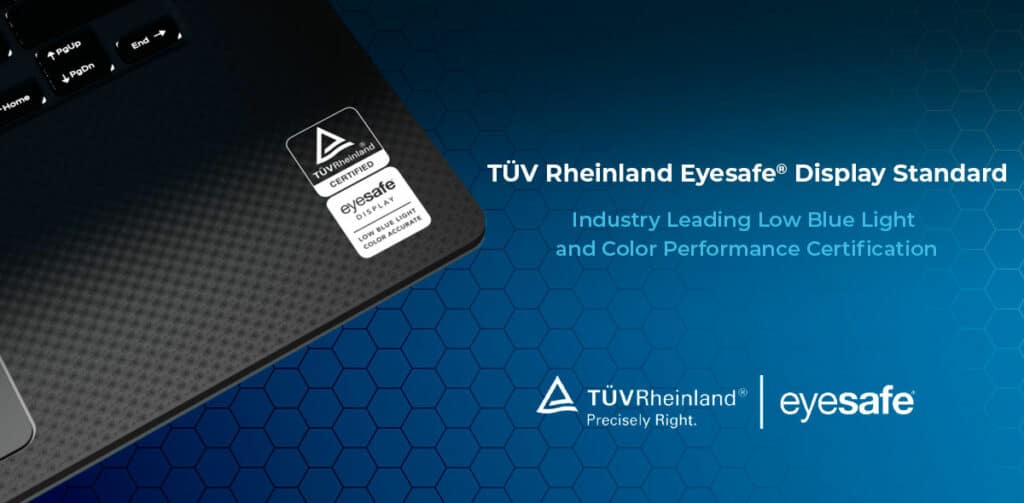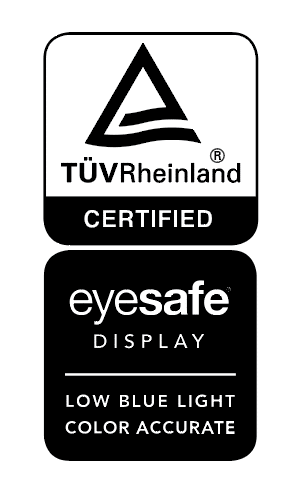• Beginning March 9, 2020, TÜV Rheinland will now be testing and certifying the Eyesafe® Display Standard, the most comprehensive set of requirements in low blue light management for the display industry.
• The Eyesafe® Display Standard constitutes the industry’s most advanced blue light emission and color performance requirements based on over 250 research studies and input from leading physicians worldwide.
• The new certification process will assist the electronics display industry, from component suppliers to consumer brands, with a guiding set of requirements for the development of low-blue light emitting displays guided by health research.
March 6, 2020 – SHANGHAI, CHINA and BERLIN, GERMANY // Today, TÜV Rheinland, the global leader in independent inspection services and third-party certification standards, announced certification for a new set of industry-leading international requirements for the consumer electronics and display industry. Entitled the Eyesafe® Display Standard, these new requirements are the first industry standards to be based on comprehensive clinical health and safety research. The Eyesafe® Display Standard is TÜV Rheinland’s recommended set of advanced requirements for the information technology industry high-intensity users across Public Sector, Enterprise, and Education verticals.
Industry-wide interest in low blue solutions and standards dramatically increased in the past 24 months which led TÜV Rheinland to partner with low blue light industry leader Eyesafe®. The rationale for releasing these new set of requirements is based on three main objectives:
• The surfeit of published research from globally-recognized private and public health, institutions has indicated that low blue light standards must be designed with the input of leading physicians and researchers in eyecare;
• The global health insurance industry has been a vocal advocate for the need for physician and health industry research-based requirements for low blue light safety and protections;
• Guiding industry leading requirements for blue light and uncompromising color performance;
The Eyesafe® Display Standard provides third-party certification for brands and suppliers seeking to identify their commitment to consumer and worker health and safety based on requirements developed in consultation with leading physicians in eyecare. The Eyesafe® Display Standard, through TÜV Rheinland’s new certification process will assist the electronics display industry, from component suppliers to consumer brands, by delivering a guiding set of requirements for the development of low-blue light emitting displays that conform to a set of standards approved by internationally-recognized leading physicians in eyecare. The next generation low blue light Eyesafe® Display Standard also comprises maximum permissible energy and color performance requirements – all guided by the latest health research and input from leaders in healthcare.
“This is a landmark moment in the global display industry,” commented Jay Yang, Vice President of Electronics at TÜV Rheinland. “We encourage all manufacturers and consumer electronics brands who are serious about the health and safety of their end-consumers to ensure that their displays are meeting the requirements of the Eyesafe® Display Standard – the first and only of its kind that is backed by research from healthcare and endorsed by leading ophthalmologists and optometrists worldwide.”
The Eyesafe® Display Standard represents the most comprehensive set of health and safety requirements for low blue light to date. In consultation with researchers and physicians at Eyesafe®, the new requirements were based on over 250 leading research studies and input from leaders in the healthcare community including world–renowned optometrists and ophthalmologists. Areas of consideration included in the development of the Eyesafe® Display Standard include the impacts of high-energy blue light, toxic spectrum and beneficial blue light spectrum, color performance and health issues including sleep, dry eye, digital eye strain and potential long-term retina health.
“For the first time, consumer electronics brands and component suppliers will have a set of standards backed by clinical health and safety research to follow in designing and managing blue light emissions on their devices,” said H. Burkhard Dick, MD, PhD, Chairman of the Ruhr University Eye Hospital in Bochum, Germany, who also serves as the President of the German Society of Cataract, Refractive and Interventional Surgery (DGII.) “So many of the past attempts to manage low blue light were made with no input from doctors in the eyecare community who are on the front line of consumer eye health and safety. The
Eyesafe® Display Standard will simplify things for consumers, IT procurement professionals, insurers, regulators and parents who can now look for the Eyesafe® Display sticker to know that the device they are using is meeting the set of requirements approved by leading eye health physicians worldwide.”
For display panel makers, Eyesafe Display certification allows for immediate promotion and sales of products to current Eyesafe brand licensees. For current Eyesafe brand licensees, Eyesafe Display certification provides the confidence their products are meeting these critical new requirements.
Devices meeting TÜV Rheinland’s certified Eyesafe® Display Standard will display a sticker, graphic or other identity label indicating that a product is in compliance with the new requirements. TÜV Rheinland will be maintaining a database of certified devices and components on their www.tuv.com.
The complete set of performance requirements and further information about the certification process is accessible at www.tuv.com.
“We are pleased to be collaborating with TÜV Rheinland on this important global health issue– screen time has exceeded waking hours for many users worldwide, and consequently, cumulative exposure to display screen and high-energy visible blue light is increasing,” observed Justin Barrett, the Chief Executive Officer of Eyesafe®. “We believe that this certification process will empower brands and suppliers to communicate to customers their commitment to health and safety of users in a transparent fashion, knowing that the Eyesafe® Display Standard is the only one designed in consultation with leading doctors from across the globe. The Eyesafe® Display Standard is the doctor-recommended solution for IT professionals looking to protects consumers, workers and children’s eyes from blue light.”
Displays meeting the certification requirements of Eyesafe® Display Standard enable access to the unique standard’s branding, labeling and identity assets for use in the marketing, promotional, and educational efforts of display manufacturers and consumer brands.
The new certification process is available beginning March 9, 2020.
About Eyesafe:
Eyesafe, the company formerly known as Healthe, is a worldwide supplier of Eyesafe® standards, Eyesafe® technology and Eyesafe® display, a suite of pioneering products and services that are shaping the consumer electronics industry’s understanding of device usage, screen time, and the impacts of blue light-emitting devices. Eyesafe® technology and the associated intellectual property portfolio was developed by a world-class team of eye doctors, engineers and scientists with decades of experience in electronics, display materials, and light management. Headquartered in Minneapolis, Minnesota, Eyesafe® works to develop technologies and standards in conjunction with leaders in healthcare.
About TÜV Rheinland:
TÜV Rheinland is a global leader in independent inspection services, founded 147 years ago. The group maintains a worldwide presence of more than 20,000 people; annual turnover is nearly EUR 2 billion. Its independent experts are committed to ensuring quality and safety for people, technology, and the environment in nearly all aspects of life. TÜV Rheinland inspects technical equipment, products, and services, oversees projects, and helps to shape processes and information security for companies. Its experts train people in a wide range of careers and industries. To this end, TÜV Rheinland employs a global network of approved labs and centers for testing and education. Since 2006, TÜV Rheinland has been a member of the United Nations Global Compact to promote sustainability and combat corruption. Website: www.tuv.com




